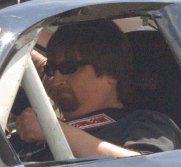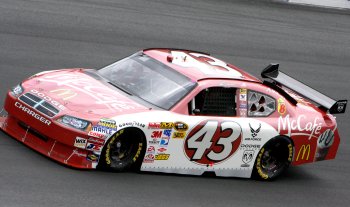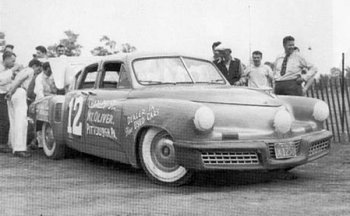
Brandon Reed
By Brandon Reed
Posted in Columns 1/15/10
The NASCAR nation has been all abuzz this week with word that the accursed “Car of Today” may soon begin to resemble the cars of yesteryear.
NASCAR is reportedly flirting with the notion of losing the IMSA style rear wing from the back of the car, replacing it with a more traditional looking spoiler. Word has been that they may also do away with the front splitter in favor of a more traditional air dam, giving the car an older style look that hopefully will be more pleasing to the fans.
For whatever reason, many fans have just not embraced the futuristic COT models, with some likening the car to the “Batmobile” of comic book fame.

Certainly, the new racer does not seem to have the same presence as past NASCAR racecars, which have traditionally been big American made cars with monster V8 engines that produce tons of horsepower.
But the COT is not the first odd car to make it’s way into NASCAR’s ranks. In fact, some of the entries that have started NASCAR Cup events in the past might surprise you.
For example, did you know that foreign car makes had competed in NASCAR’s top series long before Toyota hit the scene? In fact, a foreign made car had visited victory lane before Kyle Busch scored the manufacturer’s first victory at Atlanta back in 2008, despite NASCAR’s PR machine insisting it was the first win for a foreign nameplate.
That honor actually goes to Jaguar. The late Al Keller piloted a Paul Whiteman owned Jag to victory in NASCAR’s first ever road race, held on June 13, 1954 at Linden Airport in Linden, New Jersey. Keller outdistanced Joe Eubanks in a 1951 Hudson to record the second and final win of his NASCAR career.
What you have to understand is that, back in the 50s, Big Bill France wasn’t necessarily opposed to having foreign makes run on the big circuit. If you look through the records, you’ll see that, on more than one occasion, there were events run with these cars in the field.
In the first race at the famed Riverside Raceway, a road course, in California, several foreign makes turned up in the rundown.
While the top 17 finishers were all American made iron, the results show a pair of French built Citroens finishing 18th and 19th, piloted by Bill Jones and Ralph Roberts, respectively. Then a little further back is a Renault driven by Hylan Micka. So the foreign car make roots go a lot further back.
But perhaps the neatest of all the foreign cars known to have competed in NASCAR’s top series was in an event at Langhorne Speedway in Pennsylvania.
In that event, held on June 21, 1953, Philadelphia native Dick Hagey entered a Volkswagen Beetle in the event. Hagey’s number 18 VW qualified 32nd in the 38 car field, and putted right along in the 200 lap event to finish 19th.
That’s not too bad for a little car equipped with a four-cylinder engine that produced less than 40 horsepower!
It was the only Cup event for Hagey, and to date is the only time a VW Beetle has competed on NASCAR’s top circuit (unless you count Herbie The Love Bug in that movie from a few years back).
On a side note, according to an interview at Racer’s Reunion.com, veteran Goody’s Dash driver Horace Long says he campaigned a #77 VW Beetle in the four cylinder series for two years, and was the only one to race one of the little cars on the circuit.
But the foreign makes aren’t the most interesting of the odd cars to make starts at NASCAR’s to level. There have been more than a few interesting American makes that have made for some memorable moments.
One of the best moments occurred at Canfield, Ohio in a 200-lap event on May 30, 1950.
There really wasn’t anything overly special about the event at the half-mile dirt track. Among the cars on the starting grid were Plymouths, Fords, Mercurys, Oldsmobiles, Lincolns and even a Kaiser.
But there was one very special and very rare car prepared to start that day. It was Joe Merola’s number 12 Tucker Torpedo.
You didn’t misread that. Merola was racing a 1948 Tucker, one of only 50 such cars ever manufactured.

Joe Merola qualified this rare 1948 Tucker for a NASCAR race in Canfield, Ohio in 1950. This was one of only 50 Tuckers ever produced.
For those who may not be familiar with the story of the car, the Tucker automobile is arguably the most sought after and coveted American automobile by collectors. Preston Tucker, the cars’ designer and builder, decided to take on the big Detroit auto makers in the late 40s by designing a car that was light years ahead of its time, including safety innovations that have only hit modern cars in the last 10 years or so.
In the end, the powers that be had the Tucker plant closed down. Truth be told, they were afraid of his cars because, to be blunt, they were just too darned good.
When the doors closed forever on the Tucker plant, only 50 of the futuristic looking cars had been manufactured.
So the idea of one of those rare cars being on a half-mile dirt track is amazing, to say the least.
But the Tucker’s NASCAR debut was short lived. Merola broke a right rear axel, and the car never completed a full lap.
Incidentally, the racing Tucker is believed to have been later lost in a warehouse fire in Florida years later. It’s one of the few Tuckers that do not still survive.
So, no matter what NASCAR decides to do with the wing and the splitter on the new Car of Today, remember that it’s not the first odd-looking car to grace NASCAR’s top series.
Just think about Joe Merola’s Tucker and Dick Hagey’s Beetle. We’ll never see cars that cool on the track again.?
Brandon Reed is the webmaster and editor of Georgia Racing History.com.
Questions, comments, suggestions? Email us!
This website is not affiliated with or endorsed by the Georgia Racing Hall of Fame or the Georgia Auto Racing Hall of Fame Association, Inc. All content is the intellectual property of the individual authors. All opinions are those of the individual authors. Please do not repost images or text without permission.
